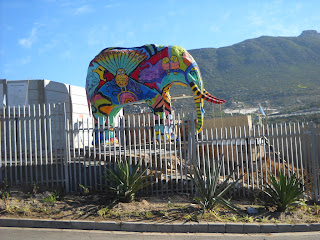Buffelsdrift ("buffalo pass" in Afrikaans) is located outside of Oudtshoorn, a picturesque Afrikaans town in the Klein Karoo ("little desert") region of South Africa, and which lies between two mountain ranges.
The Buffelsdrift Safari Lodge is built next to a dam and is a relatively new enterprise, at about 5000 acres of fenced in land and boasting 22 different wild animal species, including one white rhino, a herd of Cape Buffalo, giraffe, zebra, several kinds of antelope, six hippos, jackals and three orphaned elephants.
Safari tents across the water.
Two late-afternoon shots of the water and sky.
Lots of aloe around. In fact much of the terrain reminded me of Arizona.
Weaverbirds' nests in a tree outside Reception.
One of the safari vehicles on an early morning trip.
On top of a mountain, looking down on the valley below.
Male nyala. Lots of these around and they are very comfortable around humans, even venturing close to graze on the lawns.
Female nyala.
"Nossie", the lone white rhino. She had a mate and they produced a baby, but sadly the baby was killed by the male. This happens quite a lot. While I was there one of the old male buffalos -- "Dagga boy" -- was suspected in killing one of the two baby buffalo. Life is hard in the wild and the safari lodge owners/managers have to play a delicate game of letting nature play out, but also protecting their investment...
Stopping for a drink at the dam. Elephants can store water in 'pouches' and sometimes use it to feed other animals in the group who are sick or lame and unable to get to water themselves.
Time for the 'elies' to return home for the evening. I was told you could almost set your watch by them showing up at the gate to be led home after their long day which begins with early morning exercises, foraging and interacting with guests of the lodge and other tourists who come especially for an encounter --- including feeding, photo shoots, long rides through the preserve and watching the 'elies' show off their soccer skills. Their soccer balls are purposely kept deflated and they go through many. Malaika, (which means "Angel" in Swahili) is the best at kicking and her handlers joked that she'll soon be ready to join Bafana Bafana, South Africa's national team!
(Again: a reminder to click on any photo and enjoy a close-up slideshow.)
























































